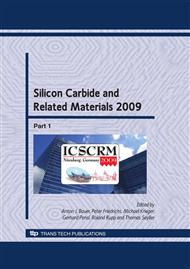p.483
p.487
p.491
p.495
p.499
p.503
p.507
p.511
p.515
Effect of NO Annealing on 6H- and 4H-SiC MOS Interface States
Abstract:
The electrical properties of the SiC/SiO2 interface resulting from oxidation of the n-type 6H-SiC polytype were studied by hi-lo CV, temperature dependent CV and constant capacitance deep level transient spectroscopy (CCDLTS) techniques. Several trap species differing in energy and capture cross section were identified. A trap distribution at 0.5 eV below the 6H-SiC conduction band energy and a shallower density of states in both the 6H and 4H polytyes are passivated by post-oxidation NO annealing. However, other ultra-shallow and deeper defect distributions remain after nitridation. The latter may originate from semiconductor traps.
Info:
Periodical:
Pages:
499-502
Citation:
Online since:
April 2010
Keywords:
Price:
Сopyright:
© 2010 Trans Tech Publications Ltd. All Rights Reserved
Share:
Citation:


